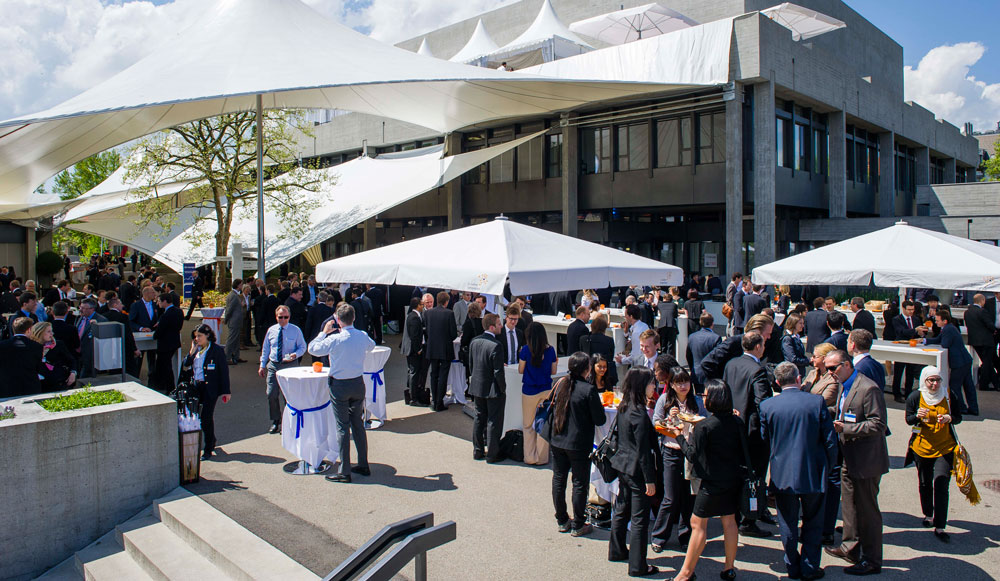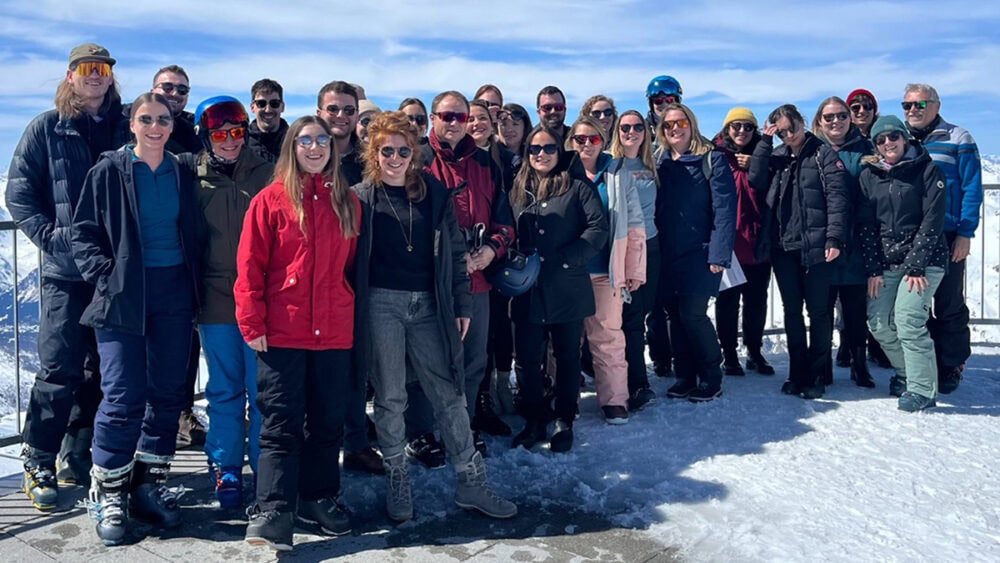Days in the environment of science
HIGHER EDUCATION In addition to their function as universities, Swiss universities also act as hosts of congresses, conferences and workshops. In most cases, the corresponding infrastructure is also available to external organizers. One of the major events held at the HSG is the St.Gallen Symposium.From April 3 to 6, 2014, the Swiss Federal Institute of Technology Lausanne inaugurated [...]

One of the major events held at the HSG is the St.Gallen Symposium.From April 3 to 6, 2014, the Swiss Federal Institute of Technology Lausanne (EPFL) inaugurated the new SwissTech Convention Center one. Designed by Lausanne architects Richter Dahl Rocha et Associés achitectes and costing 225 million francs, the building was the largest construction site in French-speaking Switzerland for months. Its history began in 2006 with a call for tenders from the EPFL, and from 2011 it was possible to start construction work, which lasted just under three years. With the completion of the congress center, EPFL's North Quarter was completed, which includes stores, services, student accommodation and a hotel.Unique in Europe"As the central element of the Quartier Nord on the EPFL campus, the SwissTech Convention Center is one of the few international convention centers in the world located directly on a large science campus," says media spokesman Jérôme Grosse. With its academic and commercial uses, it represents in many respects an infrastructure that is unique in Europe.Visually, the building at the north entrance to the university campus forms a new point of orientation, reminiscent from the outside of a polished stone. A metallic "armor" formed by the interior gradually detaches from the ground, revealing large glass fronts on the south and north sides through which daylight enters the large hall.The supporting structure of the SwissTech Convention Center is catamaran-shaped and consists of two large, three-dimensional metal beams supported by reinforced concrete service cores in the center and north of the building. The contrast between the roof coating of naturally anodized aluminum and the interior cladding of natural wood is exciting.Maximum modulation capabilityThe heart of the congress center is the large hall with space for a maximum of 3000 seats or for 4400 people. Thanks to the "Gala Systems" technology originating from Canada, it is fully modulable and is thus considered an absolute novelty. "In just 15 minutes, for example, the plenary hall can be transformed from a 2135-seat auditorium into a 1890-square-meter exhibition or banquet hall with a flat floor," explains Grosse. Thanks to this system, the SwissTech Convention Center can offer halls with 330, 468, 1670, 2135 or 3000 seats. The 865-seat indoor balcony can also be separated and converted into a 468-seat hall with its own anteroom. In addition, the garden level can be used as a large hall or divided into five, ten or 15 rooms with 40 to 200 seats.According to Grosse, the congress center is expected to appeal to international organizers of science congresses, public fairs, general meetings or other events thanks to this modularity and its central location in Europe. "The positioning at the intersection of science, culture and innovation has already led to the attraction of promising events for 2014," says the media spokesman.Already numerous occasionsAlready in April, the General Assembly of the Vaud Employers' Association with 450 participants and the 12th National Photovoltaic Conference with 700 people took place at the SwissTech Convention Center. In June, Switzerland Tourism hosts the Swiss Holiday Day in the new Convention Center. This annual event is attended by more than 1,500 decision-makers from the Swiss tourism industry, as well as representatives from politics, business, sports and culture.Also in June, the convention center hosts the International Conference of the UNESCO Chair in Development Technologies, with 350 participants, and the 38th International Symposium on Analytical Environmental Chemistry, with 400 delegates. Digital Humanities 2014 is also on the line in June with 700 researchers, and the 65th Anniversary of the International Society of Electrochemistry will be held in August with 1300 professionals.The 40th International Conference on Micro and Nano Engineering is scheduled for September with 900 engineers and scientists, followed by the EPFL Forum in October and the Planète Santé Live exhibition in November with 1000 participants each. Other events are planned for the current year.Well developedThe SwissTech Convention Center is served by the M1 metro line from Lausanne and Renens and is around 45 minutes' drive from the international airport. Guests arriving by car have 275 covered parking spaces at their disposal.The new convention center is part of EPFL's Quartier Nord, which also includes the Les Arcades complex. This houses a building with 516 beds for students, catering facilities, stores with long opening hours and the SwissTech Hotel, which offers 66 functionally furnished single and double rooms in three categories. The congress center and the Les Arcades building complex are connected by an outdoor public area.Sustainability thanks to in-house researchBecause of the unstable ground, the SwissTech Convention Center rests on 200 piles. Five of these are geothermal piles embedded in concrete and studded with sensors. Thanks to sophisticated technology, they ensure that the convention center's foundation becomes a heat source in winter and provides cooling in summer. This is a continuation of a project that began at EPFL eleven years ago.The west facade of the Convention Center also offers a novelty. Here, 300 square meters of dye solar cells were installed, which were invented at EPFL in 1991. According to Grosse, this is the first time this technology has been used on a public building. The solar cells are not only translucent, but also function regardless of the angle of light incidence. They generate renewable energy and protect the building from direct sunlight, reducing the amount of energy needed for cooling. "The installation is intended to demonstrate the potential of these solar cells and serve as a first step towards their production and use on a large scale," explains Grosse.In total, 36,800 cubic meters of concrete, 4550 tons of reinforcing steel, 900 tons of steel and 750 piles were used for the SwissTech Convention Center.Host University of St. GallenIn addition to the Swiss Federal Institute of Technology Lausanne, other Swiss universities also offer a meeting or congress infrastructure. "The HSG is not only a university, it also hosts workshops, meetings or congresses of all kinds," says Annkathrin Heidenreich, Media Relations Officer at the University of St.Gallen - School of Business, Law, Social Sciences and International Relations (HSG).To the Space available at the University of St. Gallen include a hall for up to 640 people, five lecture halls for 160 to 250 participants, 32 seminar rooms with 20 to 100 seats, and two PC labs with 30 seats each. In addition, the university has a continuing education center, including hotel services, which is primarily geared toward seminars and continuing education courses. According to Heidenreich, the HSG actively markets its conference and congress infrastructure. Among the major events held at the university are the St. Gallen Symposium, the EcoOst Symposium and the International Federalism Conference. Every year, around 20 external congresses and various small seminars and events are held at the HSG. The spectrum ranges from congresses and conferences of business and science to events of companies to internal company seminars and management meetings.Meetings in Basel and BernAlso the University of Basel makes its conference infrastructure available to external event organizers. According to Hans Syfrig Fongione, head of events at the University of Basel, this is marketed as far as possible. "It's important to us that the needs of teaching and research take priority over external requests," says Fongione.The University of Basel's facilities range from rooms with space for ten people to an auditorium with more than 400 seats. All rooms are equipped with beamers, and the university's catering can be booked if needed. "In addition, the Pharmacy History Museum, the Botanical Garden or the Old University can be used as special locations," says Fongione.The University of Basel is represented at more than 100 locations in the city, which could also be rented for events and are suitable for aperitifs, seminars, congresses, international events, celebrations, lectures or specialist events. As Fongione explains, there is still potential for more events. However, the demand for space during the semester is always very high; during the semester break, there is more free capacity. University of Bern its infrastructure, although the 224 lecture rooms with space for 8 to 342 people can also be rented. According to the university, they record around 3000 room bookings from external parties per year. Among the most important event organizers using the University of Bern's infrastructure are Insieme Switzerland, the Swiss Media Institute for Education and Culture, the Federal Department of the Environment, Transport, Energy and Communications, the Swiss Biodiversity Forum and the Swiss Society for Neuroscience. The events are congresses, conferences, meetings, lectures and meetings.Little room for maneuver in ZurichThe premises of the University of Zurich, on the other hand, cannot be rented for events. According to Beat Müller, Deputy Head of Communications at the University of Zurich, there is not enough capacity for this. "Our own events, for which there is a congress window, have priority." Exceptions, he said, are a few events per year, most of which are related to the canton of Zurich. At the ETH Zurich events from external providers can only take place if there is a direct link to ETH, teaching and research.Author: Denise Weisflog








